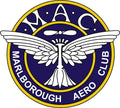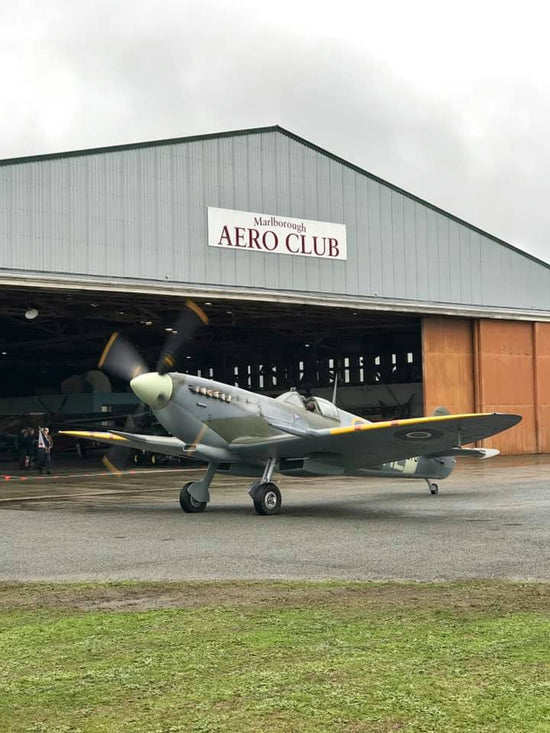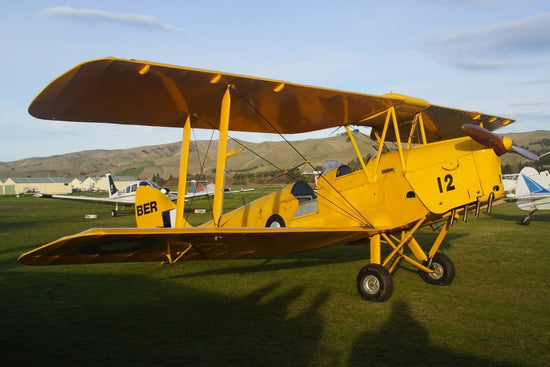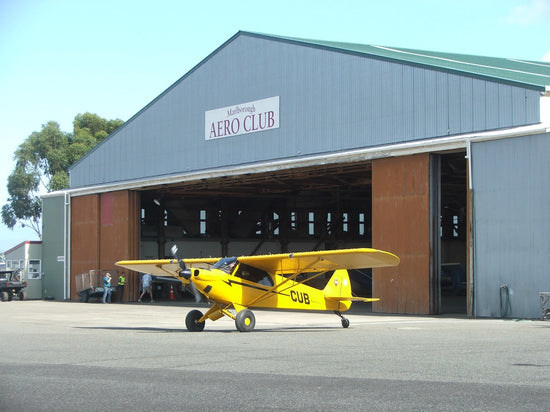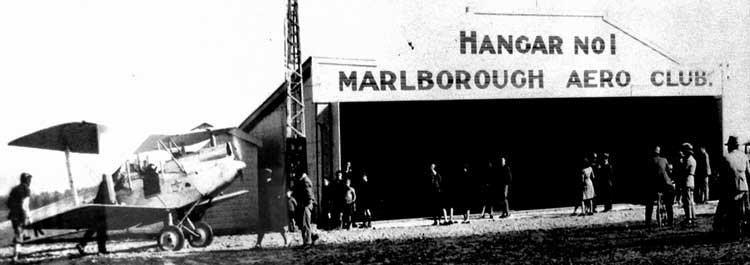
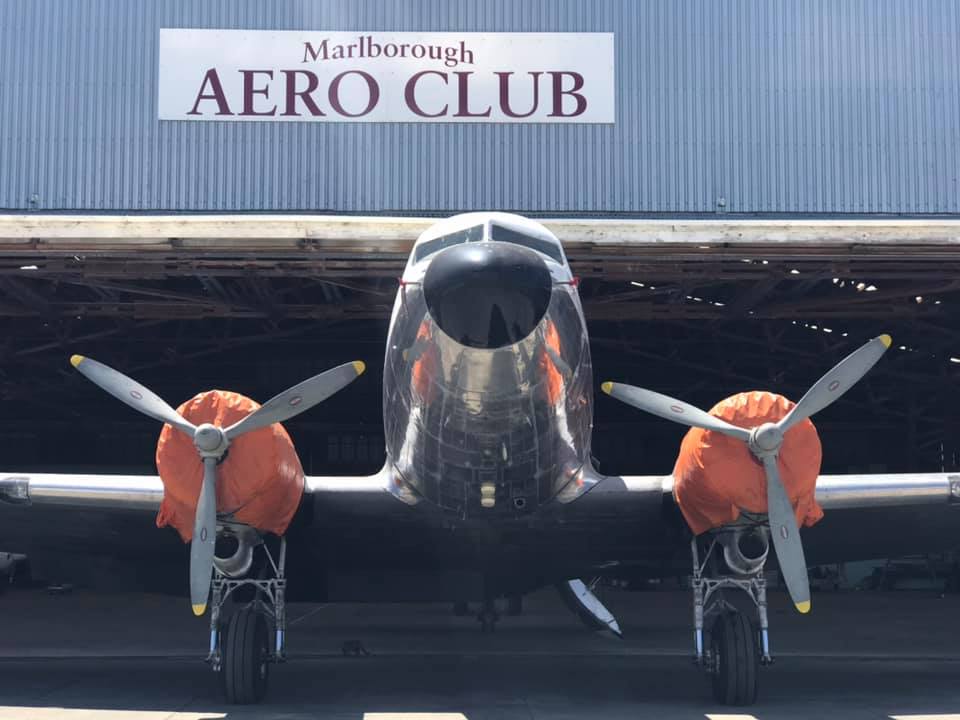

M.A.C. History
“A Club to be known as the Marlborough Aero Club...to promote, encourage, and develop the study, research, and practice of aeronautics.” This was part of the wording of a motion which was carried with great enthusiasm at a public meeting in Blenheim on 4th July 1928, formally constituting the organisation which has completed over 90 years of service to Marlborough and to New Zealand.
Soon after Euan Dickson’s pioneer crossing of Cook Strait from Blenheim to Trentham on the 25th of August 1920 proved the feasibility of linking North and South Islands by air, regular mail plane services were planned, and Blenheim became a key point in such services. Encouraged by the Canterbury Aviation Company, a local committee prevailed on the Borough Council to set aside 30 acres of the Omaka Domain for an aerodrome.
The Committee raised money and built a hangar which was finished by August 1921, but by this time economic conditions had forced the withdrawal of government support which had been expected.
When better times came again, the Government decided that the best way to develop civil aviation was to foster a club movement in which young people could learn to fly. Blenheim was fortunate that one of its citizens was Mr. N. E. Chandler, who had been a Captain in the Royal Flying Corps in World War I. Well and favourably known to the authorities, he was just the man to make the most of the opportunity and was able to enlist the necessary support.
Messrs K. Hall, of Hororata, and D. Mill, of Auckland, the first two owners of light aircraft in the country, had been invited to attend the inaugural meeting. Held up by weather, they came two days later, gave a flying exhibition, took some passengers up, and dropped leaflets over town urging people to join the new Club.
Two months later when the Southern Cross had made the first flight over the Tasman from Sydney to Christchurch, and Kingsford Smith was seeking a larger and better-situated field for his return take off with a heavy fuel load, it was Marlborough’s new Aero Club which brought him to Blenheim and secured the use of Fairhall Brothers’ paddocks at Woodbourne.
By the time this flight had been successfully accomplished, interest in flying was intense and the Club had pupils eagerly awaiting tuition. On 3rd August 1928 the Mayor Mr. H. Richardson took a deputation of M.A.C. committee members to Wellington to further the M.A.C. application for the allocation of two aircraft for flight training. To their surprise and consternation, they were informed that the Defence Department had already exceeded their appropriation and that no aircraft would be available until the following year. An offer by the M.A.C. to finance an earlier allocation was made but not eventually required. Five months later it was allocated the first of the Gipsy Moths imported by the Government for the movement, and although not quite the first to be formed, it became on the 19th of February 1929 the first Aero Club to have an aeroplane and start flying operations. The aircraft was registered NZAX which later became ZK-AAM
Marlborough Aero Club’s base was the Omaka Domain aerodrome and hangar which had been ready for use since 1921. Mr. Chandler, of course, was the instructor, continuing in this capacity until he decided to retire from flying in 1937. His first ground engineer was Mr. J. H. Preston.
The first executive comprised the Mayor, Mr. M. McKenzie, as Patron; President, Mr. H. R. Dix; Vice-President Mr. R. P. Furness; Hon. Treasurer, Mr. R. H. Jackson; Hon. Secretary, Mr. C. A. MacDonald; Committee, Messrs A. A. Macnab, N. G. Parker, F. R. Dix, H. M. W. Richardson, J. G. Bacon and N. E. Chandler. Three months after flying began Messrs F. R. Dix, R. C. Grigg and H. H. Vavasour secured their “A” Licences. They were New Zealand’s first Club trained pilots. Another early pupil, Miss Pauline “Susie” Bennett went on to become the first woman in the country to qualify for a “B” or Commercial Pilot Licence.
M.A.C. held New Zealand’s first Air Pageant on 9th March 1929. At the time it held the second Air Pageant in 1930, Marlborough convened a meeting of Clubs at which the organisation which became the Royal New Zealand Aero Club was formed.
During the early 1930’s a steady programme of development went on. A small shed to hold two Moths with wings folded was put up at Woodbourne so that flying could be based there while improvements and extensions were made at Omaka. The hangar was moved to a new position and a workshop erected. The Woodbourne Shed was later joined to them.
A handsome Clubhouse was built and furnished, and two bitumen tennis courts laid down. The Clubhouse was completed in late 1932 and the Club celebrated the official opening with an Air Pageant on 10th December 1932. Also in 1932, the Club purchased approximately 35 acres of land adjacent to the Omaka Domain land.When an Aero Club was formed in Nelson late in 1932 an arrangement was made for Marlborough to supply the instructor and aircraft part time, and the Moths became familiar sights over Nelson and Motueka as well as Blenheim.
In 1937 the Government established a Civil Reserve of Pilots, its members being trained by the Aero Clubs, and Marlborough played a full part in this scheme. When war came in 1939 these reservists became part of the Air Force, which also took over the Club’s aircraft, workshop equipment, and flying and engineering staff. Other members joined up and several lost their lives in the service of their country. The existence of the Clubs enabled Air Force training stations to be fully operating in a matter of weeks instead of months or years it may otherwise have been. Later, Omaka aerodrome was taken over and our own buildings became the nucleus of an RNZAF Station.
Late in 1946 the Club was able to resume operations. The late R. B. Hamilton, who joined as instructor in 1947, was the driving force in the early post-war years. As well as training a large number of pilots, he developed a business in air freighting to back-block areas, supply dropping to deer cullers, and aerial rabbit poisoning, to improve aircraft utilisation and supplement the Club’s income.
This work gradually tapered off as it was taken over by aerial topdressing operators, and passenger flying between Omaka and Rongotai became the main commercial activity when the airlines were diverted to Paraparaumu for several years. In the peak year, 1952, with continuous service by a 3-passenger air taxi, 4500 people were carried between Blenheim and Wellington.
In 1955 a group of enthusiasts wishing to introduce gliding to Marlborough were brought into the fold, they built the Slingsby T31 glider and gliding was conducted by the Club for two years. It was then decided that a separate Gliding Club should be formed.
Large scale air taxi activities, as was expected, ended with the coming of improved airline services and the opening of the new Wellington Airport. For a while the Club was assisted by the training of Air Training Corps Cadets for the Air Force, but this came to an end and now no form of Government aid has been extended to Aero Clubs.
Training of young and not so young members, local flying and travel by trained pilots, and a small amount of charter work, coupled with wise management have been keeping the Club in a healthy financial position, assisted by rents from the large war time hangar which was bought from the Government in 1963.
Starting from the day in 1929 when one of the Moths was commissioned to locate a service car cut off by road damage in the Buller Gorge at the time of the Murchison earthquake on 17th June 1929, the Marlborough Aero Club has proved its usefulness to the community many times. People needing urgent transport have been flown to all parts of the country, patients have been conveyed by air on stretchers for treatment by city hospitals, supplies have been dropped to homes cut off by floods, accident victims have been flown out from isolated areas. Of those who have had their first flying in a Marlborough Aero Club plane, some have risen to senior positions in aviation; all have been taught to exercise sound judgement, self-reliance, and a sense of responsibility.
Club membership is in a healthy state, flying training is at a high level and airfield occupancy with its related income is also at a high level.

